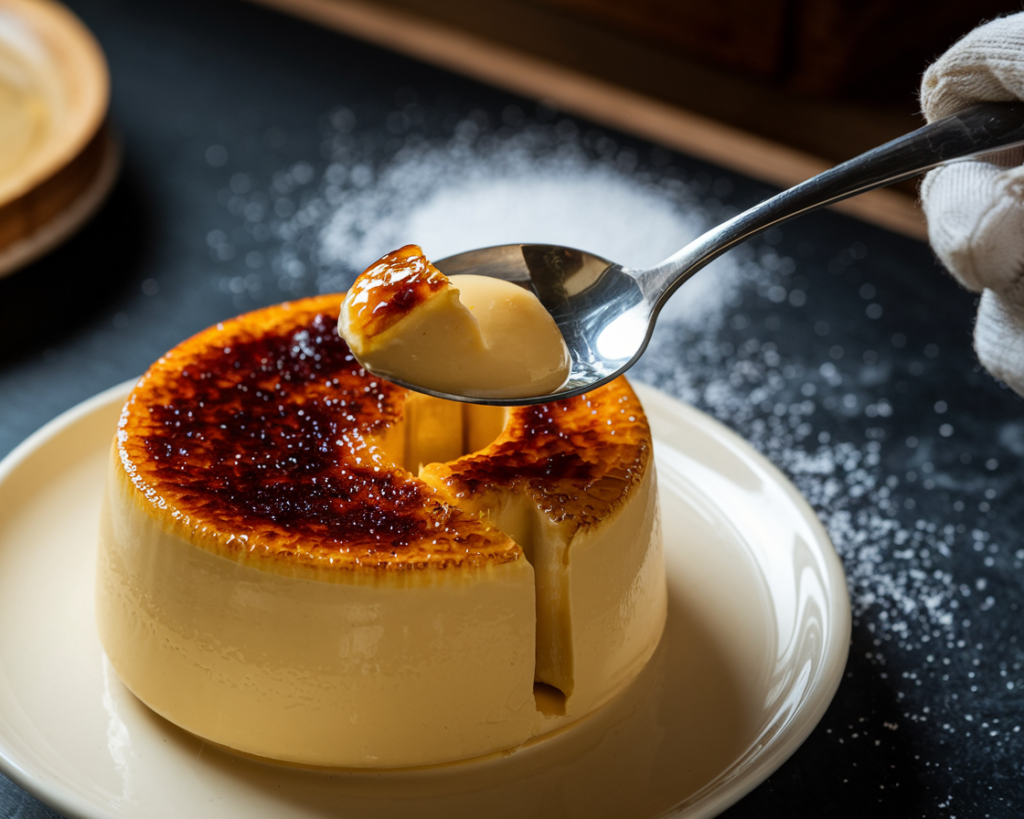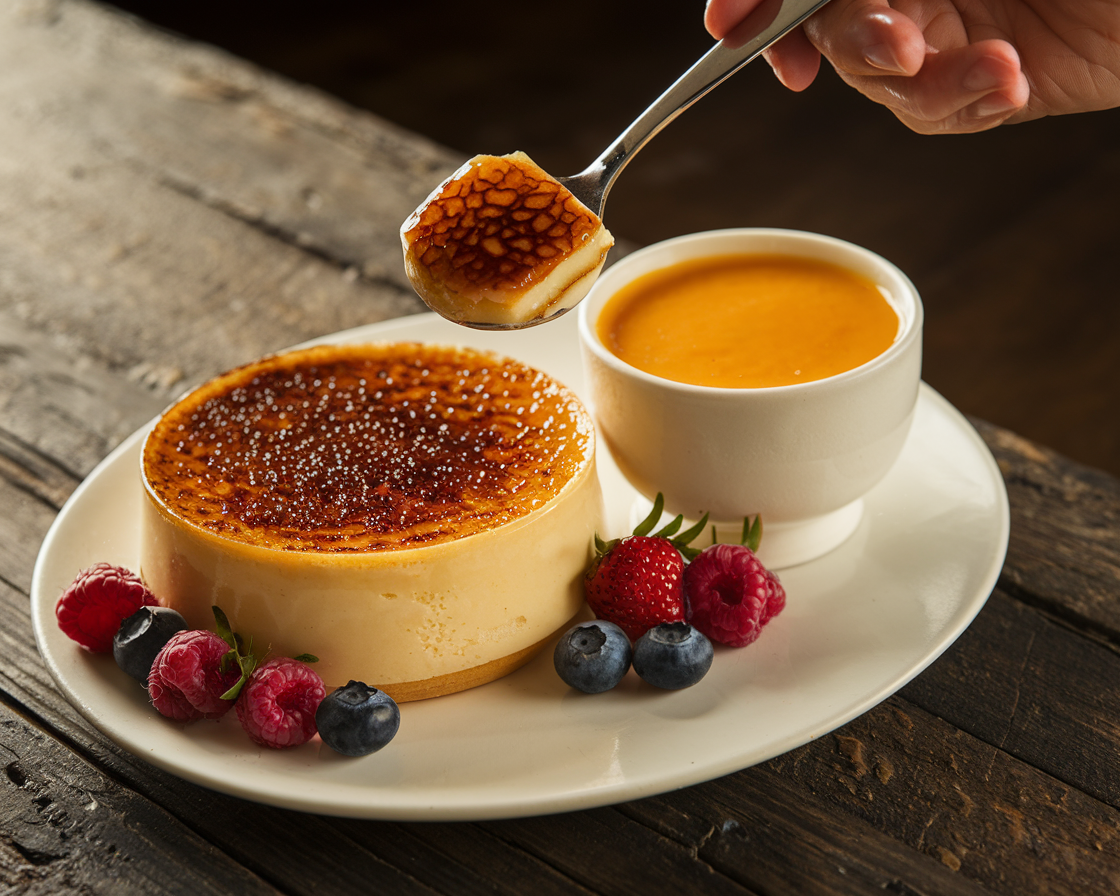If you’ve ever stared at a dessert menu wondering if you should go for the crème brûlée or custard, you’re not alone. Both are creamy, luscious, and irresistibly delicious, yet they’re not quite the same. So, what sets these two apart? Let’s dive into their history, ingredients, and preparation to uncover the differences and similarities.
Introduction to Crème Brûlée and Custard
Crème brûlée and custard are like cousins at a family gathering—they share some traits but have unique personalities. While both are made with similar ingredients, their textures, flavors, and even the way they’re served make them stand out.
A Brief History of Crème Brûlée
Crème brûlée, often dubbed the queen of desserts, traces its roots back to 17th-century France. The term literally means “burnt cream,” referring to the caramelized sugar layer on top. This fancy treat was originally served at royal banquets, wowing guests with its crunchy top and creamy interior.
“Crème brûlée isn’t just a dessert; it’s an experience—the joy of cracking the caramelized shell is half the fun!”
The Origins and Evolution of Custard
Custard, on the other hand, has a much older history. Its origins date back to the Middle Ages, where it was used as a filling for pies. Over time, custard evolved into its own standalone dish, thanks to its versatility. From baked custards to stovetop puddings, it became a staple in kitchens worldwide.
“Custard is the ultimate comfort food—it’s simple, wholesome, and makes you feel like you’re wrapped in a warm hug.”
Understanding the Basics: What Are They Made Of?
To truly grasp the difference, let’s look at their ingredients. Surprisingly, they start with nearly the same base: eggs, sugar, and milk or cream.
Key Ingredients of Crème Brûlée
- Egg Yolks: These give crème brûlée its rich, velvety texture.
- Heavy Cream: The foundation of its creamy base.
- Sugar: Not just in the mixture but also for that iconic caramelized top.
- Vanilla: Adds a delicate aroma and flavor.
The Essential Ingredients in Custard
- Eggs: Whole eggs or just yolks, depending on the type of custard.
- Milk or Cream: Often milk is used for a lighter texture, but cream can be added for richness.
- Sugar: Sweetens the custard.
- Flavoring: Think vanilla, nutmeg, or even citrus zest.
| Ingredients | Crème Brûlée | Custard |
|---|---|---|
| Eggs | Yolks Only | Whole Eggs or Yolks |
| Dairy | Heavy Cream | Milk or Cream |
| Sugar | Caramelized on Top | Mixed In |
| Flavorings | Vanilla | Vanilla, Nutmeg |
Preparation Techniques: How Are They Made?
The way these desserts are prepared plays a significant role in their differences. While both involve cooking a custard base, the techniques diverge dramatically.
Making the Perfect Crème Brûlée: Techniques and Tips
Crème brûlée is baked in a water bath to ensure even cooking. The real showstopper, though, is the caramelized sugar topping. After the custard is set, sugar is sprinkled on top and torched until it forms a glass-like crust.
Tips for Success:
- Use a kitchen torch for precise caramelization.
- Chill the custard thoroughly before adding sugar.
- Go for superfine sugar—it melts more evenly.
The Art of Preparing Custard: Methods and Variations
Custard is versatile, and the preparation depends on the type. Baked custard is slow-cooked in the oven, while stirred custard requires constant attention over the stove to avoid curdling.
Tips for Success:
- Stir continuously when making stovetop custard.
- Strain the mixture for an ultra-smooth texture.
- Cool baked custards in their water bath to prevent cracking.
“Desserts are like people; it’s the little details that make them unique. Crème brûlée dazzles with its crunchy top, while custard wins hearts with its smooth simplicity.”
Textural Differences: Smoothness vs. Crunch
One of the first things you’ll notice when eating crème brûlée or custard is their texture. This difference alone can make or break your dessert choice!
The Silky Texture of Custard
Custard is renowned for its smooth, creamy consistency. Whether baked, stirred, or steamed, custard is like a comforting hug in dessert form. It melts in your mouth, leaving a velvety finish that feels indulgent yet simple.
Ever wondered why custard feels so smooth? It’s all about the eggs and gentle cooking. The proteins in eggs thicken the milk or cream without curdling, creating that perfect consistency.
The Signature Crackle of Crème Brûlée’s Caramelized Top
Crème brûlée, on the other hand, offers a delightful contrast in textures. You’ve got that crisp, caramelized sugar shell on top, hiding the creamy custard underneath. Breaking through the caramel is a sensory experience—you hear the crunch before tasting the smooth custard below.

“The sound of a spoon cracking the caramelized top of crème brûlée is music to a dessert lover’s ears.”
Flavor Profiles: Subtle vs. Decadent
While both desserts can be flavored with similar ingredients, their final taste profiles differ significantly.
Flavor Complexity in Crème Brûlée
Crème brûlée is all about balance. The burnt sugar topping introduces a slight bitterness that complements the sweetness of the custard. Add in a touch of vanilla or even citrus zest, and you’ve got a dessert that’s elegant and refined.
How Custard Balances Simplicity with Versatility
Custard, in contrast, shines through its simplicity. It’s not flashy, but its subtle flavor makes it incredibly versatile. Whether served as-is or used as a base for pies, trifles, or ice cream, custard adapts to whatever flavor you want to add.
| Aspect | Crème Brûlée | Custard |
|---|---|---|
| Texture | Crunchy top, creamy base | Smooth and creamy |
| Flavor | Sweet with a caramel note | Mild and versatile |
| Cooking Method | Baked with a caramel layer | Baked or stovetop |
Presentation: The Visual Appeal
How a dessert looks can often be just as important as how it tastes. Both crème brûlée and custard bring their own charm to the table.
The Elegant Look of Crème Brûlée
There’s no denying that crème brûlée is a showstopper. Its golden, caramelized crust gleams under the light, practically begging to be cracked open. It’s typically served in individual ramekins, making it perfect for special occasions.
Custard’s Role in Culinary Versatility
Custard may not have the same visual drama, but its versatility is unmatched. It can be served in simple bowls, layered in trifles, or poured into pie crusts. Its unassuming look hides the fact that it’s a dessert powerhouse.
“Crème brûlée is the red carpet diva of desserts, while custard is the down-to-earth friend you can always count on.”
Common Problems and Solutions
Even experienced cooks can run into trouble when making these desserts. Let’s tackle some of the most common issues and how to fix them.
Why Does My Crème Brûlée Not Set Properly?
The custard base of crème brûlée can sometimes stay runny, especially if undercooked or baked at the wrong temperature.
Solution:
- Bake in a water bath to ensure even heat distribution.
- Check the center—it should jiggle slightly when done but not be liquid.
Fixing Grainy or Overcooked Custard
A custard that turns grainy likely curdled during cooking due to high heat.
Solution:
- Use low, steady heat and stir constantly for stovetop custards.
- Strain the mixture before cooking to remove any bits of egg.
Tips to Perfect the Caramel Layer on Crème Brûlée
Caramelizing the sugar on top of crème brûlée can be tricky—it can burn easily or fail to form a proper crust.
Solution:
- Use a torch for controlled caramelization.
- Sprinkle an even layer of sugar and avoid thick patches.
Popular Variations and Regional Twists
Both crème brûlée and custard have inspired countless variations around the world. Whether you prefer traditional recipes or want to experiment with new flavors, there’s something for everyone.
Modern Twists on Classic Crème Brûlée
Crème brûlée is often reimagined with exciting ingredients that elevate its traditional flavor profile.
- Matcha Crème Brûlée: Adds a vibrant green hue and earthy taste with matcha powder.
- Chocolate Crème Brûlée: A decadent twist for chocolate lovers.
- Lavender Crème Brûlée: Infuses a floral note for a sophisticated dessert.
- Fruit-Infused Variations: Raspberry, mango, or passionfruit purées add tangy sweetness.
Global Takes on Traditional Custard
Custard’s versatility means it’s embraced by various cuisines in unique ways:
- Portuguese Pastéis de Nata: Custard-filled tarts with a flaky crust.
- British Trifle: Layers of custard, sponge cake, and fruit.
- Japanese Purin: A flan-like custard topped with caramel sauce.
- Indian Kheer: A spiced rice custard with nuts and dried fruits.
If you’re intrigued by the nuances between crème brûlée and custard, you might also enjoy exploring our Crab Brulee Recipe: Luxurious and Easy to Make. This unique twist combines the creamy texture of traditional brûlée with the savory richness of crab, offering a delightful fusion that’s both indulgent and straightforward to prepare. It’s a must-try for those looking to expand their culinary repertoire with innovative and delectable dishes.
Nutritional Comparisons: Which Is Healthier?
Desserts don’t always have to derail your health goals. Let’s compare crème brûlée and custard from a nutritional standpoint.
| Nutrient | Crème Brûlée (per serving) | Custard (per serving) |
|---|---|---|
| Calories | ~250–350 | ~150–250 |
| Protein | ~4g | ~6g |
| Fat | ~25g | ~10g |
| Sugar | ~20g | ~15g |
Healthier Alternatives and Substitutions
- Use low-fat milk instead of cream in custards for fewer calories.
- Sweeten with natural alternatives like stevia or honey.
- For crème brûlée, try a coconut cream base for a dairy-free option.
Pairing Suggestions: What Goes Best with Each Dessert?
Choosing the right pairing can enhance the flavor of your dessert and make the experience even more enjoyable.
Ideal Pairings for Crème Brûlée
- Beverages: Pair with a glass of dessert wine, such as Sauternes, or a robust espresso.
- Accompaniments: Fresh berries or a side of shortbread cookies provide a delightful contrast.
Creative Ways to Serve Custard
- As a Filling: Use custard in pies, éclairs, or profiteroles.
- With Fruit: Top with caramelized bananas or poached pears for a fruity twist.
- Beverages: Pair with light herbal teas or a cappuccino.
“The beauty of desserts lies in their ability to bring joy to any occasion. Whether it’s the crunch of crème brûlée or the smoothness of custard, there’s always room for indulgence.”
Choosing Between Crème Brûlée and Custard
Still not sure which dessert to pick? Here’s how to decide:
When to Choose Crème Brûlée
If you’re in the mood for something luxurious and crave that satisfying caramel crunch, crème brûlée is your go-to. It’s perfect for impressing guests or treating yourself to something special.
When Custard Is the Better Option
If simplicity and versatility are what you’re after, custard wins the day. It’s comforting, easy to make, and pairs well with just about anything.
Conclusion: Appreciating Both Desserts for Their Unique Charm
At the end of the day, both crème brûlée and custard are winners in the world of desserts. Each brings its own unique charm to the table, whether it’s the crunch of caramelized sugar or the silky smoothness of a classic custard.
So why not try making both and decide which one steals your heart? After all, life’s too short not to enjoy the best of both worlds! 🍮✨

